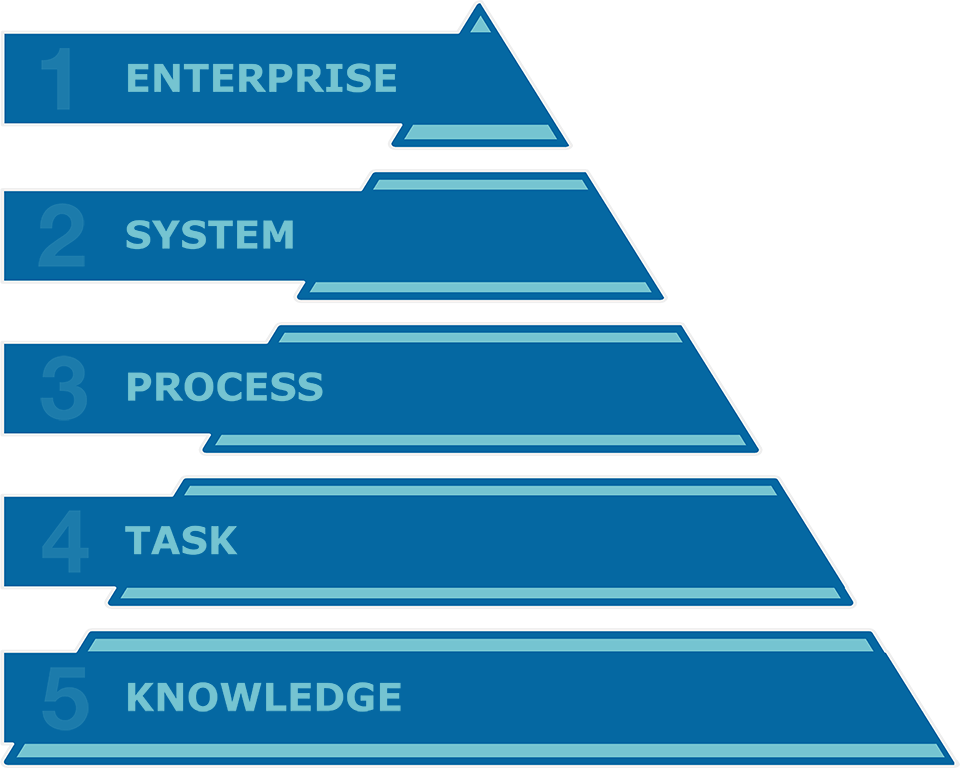Business Process Architecture
Business Enterprise Mapping
The Five Levels of Work in Every Organization
Organizations create value through the work they perform, with a primary goal to excel at that work. Work is executed through tasks that flow horizontally across organizational boundaries from department to department, function to function, and job to job. These workflows connect through business process architecture levels. Employees access knowledge to perform tasks and multiple tasks combine to create processes. Processes link to form business systems, and business systems connect to build the overall enterprise workflow. A workflow-based management structure works seamlessly to facilitate the movement of work through this structure, removing barriers that get in the way of successful performance. The five standard levels of work are briefly defined following.

Enterprise
Contains Business Systems
Level One - Enterprise contains the business systems (functions) necessary to deliver enterprise purpose as it relates to customer management, value proposition delivery, resource management, supporting administration.
Business System
Contains Business Processes
Level Two - A Business System is comprised of business process architecture mapping connecting processes together to provide a value proposition that accomplishes the broader purpose of the business system. Any business can find all or most of the processes and systems described by our enterprise model’s twelve business systems. A notable exception could be a system that is unique for an industry type, such as Production Management which might vary greatly depending on what products or services the company provides. Systems and processes will deliver multiple products and/or services to their customers. When applying our model, we focus on the main outputs delivered.
The Twelve Enterprise Business Systems
1. The Enterprise Management System
The Enterprise Management System oversees enterprise governance, strategy and planning, M&A activities, scorecard and monitors organization performance.
2. The Financial Management System
The Financial Management System manages and monitors the flow of capital through the enterprise, including financial transactions, accounting and financial metrics.
3. The Facilities Management System
The Facilities Management System identifies, acquires, develops, constructs, maintains and disposes of facilities while safeguarding its employees and the surrounding community to provide a suitable working environment.
4. The Equipment Management System
The Equipment Management System specifies, installs, calibrates and maintains equipment utilized to deliver the firm’s value proposition.
5. The Employee Management System
The Employee Management System manages the employee lifecycle to plan, hire, qualify, manage, train and develop, and terminate employees.
6. The Information Management System
The Information Management System manages the information infrastructure, operations and data that supports the business requirements, ensuring essential information is secure, current, and readily available when and where needed.
7. The Customer Management System
The Customer Management System seeks, finds, acquires, onboards, and manages customer relationships throughout the customer lifecycle. This includes Marketing, which is responsible for attracting qualified prospects and Sales, which is responsible for converting prospects to retained customers.
8. The Solution Management System
The Solution Management System conceives, plans, develops, tests and delivers new products and services, and manages product/services life cycles.
9. The Supplier Management System
The Supplier Management System manages and monitors the suppliers of materials and services to the enterprise, covering the complete supplier life cycle, from sourcing, qualification, onboarding, contracts, development, and management through disqualification.
10. The Operations Management System
The Operations Management System executes the enterprise value proposition through the management of materials, production and delivery of products and services to customers.
11. The Service Management System
The Service Management System manages postproduction services, including installation, maintenance and service management, and customer follow-up, complaint handling and resolution.
12. The Improvement Management System
The Improvement Management System organizes, manages, and monitors enterprise performance improvement, including products, services and processes, customer feedback and response, opportunity analysis, and corrective action. It ensures the enterprise operates responsibly through third party compliance, produces products and services that meet specified requirements, while continuously improving enterprise performance.
Business Processes
Contains Business Tasks
Level Three – Business Processes take inputs from suppliers, transform them through a series of connected tasks, and deliver those transformed outputs to process customers. Contiguous business process architecture mapping connects to deliver the larger business system purpose. Our experience shows most Business Systems contain, on average, between eight and sixteen business processes. This means most organizations contain roughly 120-150 business processes in total.
Tasks & Decisions
Contains Knowledge & Decisions
Level Four – Tasks & Decisions represents a series of tasks (jobs, actions, meetings), and decisions (yes/no, go/no-go) that combine to transform a supplied input into a delivered output that a customer values. We find that task counts for most processes easily range from about 25 to 50 tasks
Knowledge
Contains & Imparts Clarity
Level Five – Knowledge is the intellectual property of the enterprise. Knowledge includes a wide variety of information, such as records, data, policies, standards, training, metrics, regulatory, bills of materials, specifications, trademarks and patents. Knowledge is accessed and utilized by business processes through tasks and decisions.
